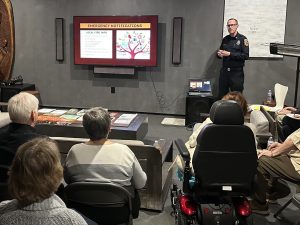
The San Diego Regional Fire Foundation awarded grant funds earlier this year to the Alvarado Estates Fire Safe Council (AEFSC), to help address wildfire risks in the neighborhood and nearby gateway to College Area and San Diego State University (SDSU). The San Diego Regional Fire Foundation provides grants throughout San Diego County to support community fire prevention programs.
The AEFSC is one of 46 community-led groups of Fire Safe Councils of San Diego County. As such, it has a required and now approved Community Wildfire Protection Plan which guides its program initiatives for homeowners, as well as efforts to protect the nearby wildland-urban interface where natural vegetation exists in the canyons and on hillsides around the neighborhood.
These funds provide for a series of educational workshops and support for residents to learn about and implement proven strategies to reduce wildfire risks to their families, their pets and their properties. On Nov. 8, the AEFSC held its first Wildfire Preparedness Workshop for residents. Five fire officials took part in the workshop, contributing their valuable professional knowledge and guidance.

Captain Thomas Shoots from CAL FIRE started the meeting by sharing a PowerPoint presentation about building community resilience to wildfire. He explained wildland fire behavior factors (i.e., topography, fuel and weather), and told residents what to expect if given an evacuation warning (for potential threat) or an evacuation order (when there is an immediate threat to life and/or property).
Shoots said that conditions such as triple digit temperatures, wind and the challenging topography around Alvarado Estates can make it extremely difficult and dangerous for ground crews to fight wildfire. He further explained that in this case, a fire agency might try to throw all their resources at the fire early on, like aerial drops, to prevent the fire from spreading. He also shared recommended wireless emergency alerts which residents can sign up for, such as AlertSD.
Officials from San Diego Fire-Rescue (SDFR) also contributed to the success of the meeting.
Anthony Tosca, a Deputy Fire Chief who is also the San Diego Fire Marshal, took time to set the stage for this important community initiative. In an advance communication to workshop planners, Eric Sands and Karen Austin, he stated, “We’re looking forward to meeting with you and the community to discuss wildfire preparedness. Thanks for being proactive to make your community safer! It’s this type of collaboration and community engagement that we look forward to.”
At the event, Tosca impressed residents with his regard for their well-being and the safety of all the residents in the College Area. He drew from his years of field and leadership experience to give those in attendance a clear sense of the impact wildfire can have on a community and encouraged them not to wait to put into action the important steps they were learning about at the meeting. He indicated that the AESFC was on the right track by using awarded grant monies to both educate and assist the community to create defensible space and “harden” their homes, most of which were built in the 1950s and 1960s, against the threat of wildfire.
Educating the public at community forums and fire safety fairs
Steven Macias and Raquel Elias, SDFR Code Compliance Officers, also shared about their jobs to provide education to the public at community forums and fire safety fairs, as well as conduct field investigations to help ensure compliance with City codes and regulations. They also respond to received complaints, issue notices of violation when necessary and conduct California Assembly Bill 38 defensible space inspections for residential properties sold as of July 1, 2021, which are located in High or Very High Fire Hazard Severity Zones (as is the case for College Area and most of the City).
Captain Alma Lowry, a Community Resource Officer with SDFR (pictured in lead photo) informed the group about her specialized work to model wildfire behavior using maps as well as evaluating fire ignition data, terrain slope, characteristics of vegetation fuels, weather, wind and more, to predict the impact of a fire. She then works to establish evacuation plans using her findings and other tools like census maps, to guide San Diegans to safety.
Captain Lowry told AE residents what to expect in the event of an evacuation and to use available fire safety resources to prepare well in advance for wildfire and possible evacuation.
The attendees received a number of booklets and flyers made available by SDFR, CAL FIRE, San Diego Humane Society, The San Diego Regional Fire Foundation, Fire Safe Councils of San Diego County and other organizations. They include information to help make a household safety plan, learn about suggested emergency supplies for the home as well as a “go-kit” of essentials, prepare for pet safety, and other proactive steps to take now.
This first of three planned Wildfire Preparedness Workshops helped renew residents’ attention on the very important conversations and actions which are necessary to be well-prepared for wildfire. It’s not IF, but when!
More workshops planned to specifically cover recommendations
At least two more workshops are planned to specifically cover recommendations to 1) create defensible space by managing vegetation in three specific zones around a home, 2) harden residential structures by using ember-resistant vents and other measures to increase resistance to radiant heat, flame contact and flying embers which accompany most wildfires and 3) obtain adequate fire insurance coverage.
Future AEFSC wildfire prevention goals include fuels management projects. One of the priorities for vegetation management in this area is along Fairmount Avenue and Montezuma Road, a major gateway to College Area and SDSU. Considered an at-risk area for fire ignition by natural effects of climate change, as well as human-caused means like discarded smoking materials, vehicle chain strikes and homeless encampments.
To register for AlertSD and learn about other resources and opportunities go to:
https://www.sandiego.gov/oes/informed













Discussion about this post